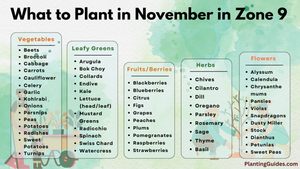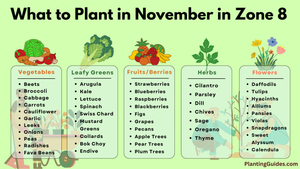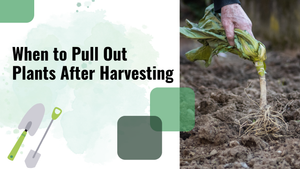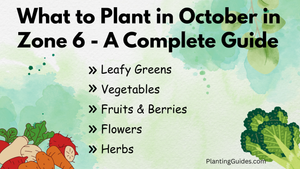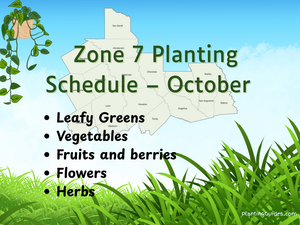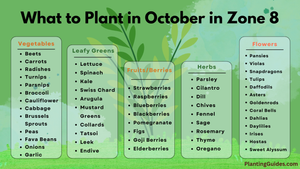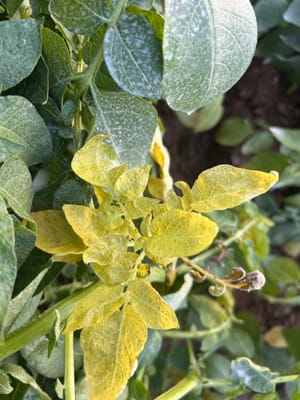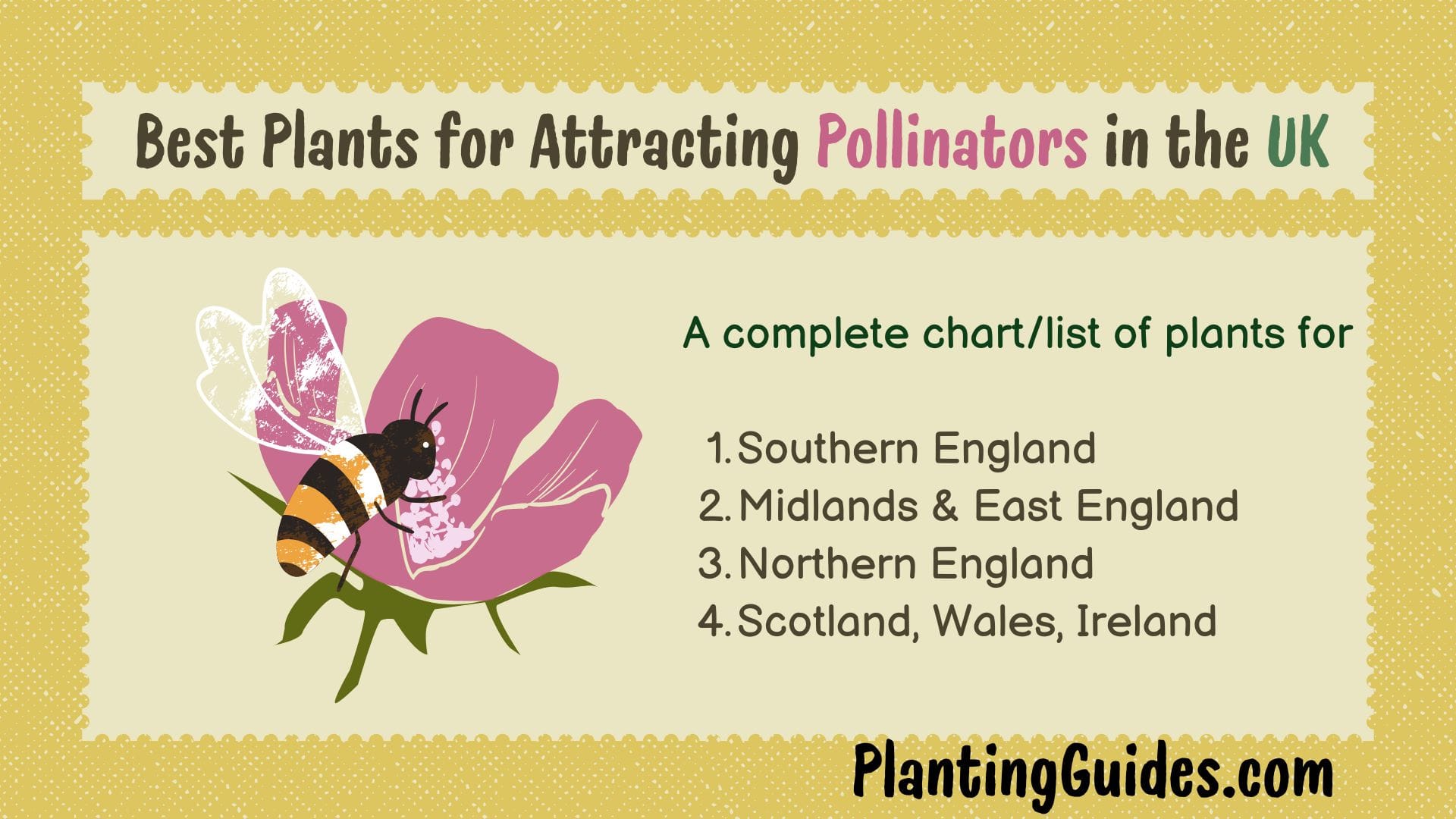
Pollinators like bees, butterflies, and hoverflies are important for a great and healthy garden. They help plants produce fruits/seeds, which are important for the continuation of plant life and maintaining a diverse ecosystem. Picking the right plants is a big deal to attract these helpful creatures to your garden.
In this guide, I will show you the best plants to attract pollinators in the UK and how to make your garden a welcoming spot for them.
Below, I have provided tables for each region of the UK, listing the best plants to attract pollinators. This will help you choose the right plants for your area.
Southern England - Best Plants for Pollinators
Southern England has nice weather, warm in summer and not too cold in winter. This makes it a great spot for plants like Lavender and Butterfly Bush, which love dry, sunny places and don’t need much water.
These plants grow well in soil that drains easily and give bees and butterflies lots of sweet nectar all season long.
| Plant Name | Type | Pollinator Type | Flowering Season | Growth Speed | Growth Conditions |
|---|---|---|---|---|---|
| Lavender (Lavandula angustifolia) | Perennial | Bees, Butterflies, Moths | Summer | Medium | Full sun, well-drained soil |
| Butterfly Bush (Buddleja davidii) | Perennial | Butterflies, Bees | Summer-Autumn | Fast | Full sun, tolerates poor soil |
| Purple Coneflower (Echinacea purpurea) | Perennial | Bees, Butterflies, Flies | Summer-Autumn | Medium | Full sun/Partial shade, fertile soil |
| Wood Sage (Salvia nemorosa) | Perennial | Bees, Butterflies | Summer | Medium | Full sun/Partial shade, well-drained soil |
| Cranesbill (Geranium rozanne) | Perennial | Bees, Butterflies | Summer-Fall | Medium | Full sun/Partial shade, moist soil |
| Hawthorn (Crataegus monogyna) | Tree | Bees, Butterflies | Spring | Fast | Full sun, tolerates poor soil |
| Foxglove (Digitalis purpurea) | Biennial | Bees, Butterflies | Late Spring-Summer | Fast | Partial shade, moist soil |
| Ivy (Hedera helix) | Climber | Bees, Wasps | Autumn-Winter | Fast | Shade/Partial shade, tolerates poor soil |
| Mahonia (Mahonia aquifolium) | Shrub | Bees | Late Autumn-Winter | Medium | Partial shade, well-drained soil |
| Winter Heather (Erica carnea) | Shrub | Bees | Winter-Spring | Slow | Full sun, well-drained soil |
Southern England’s gentle weather is great for plants that bloom for a long time and bring bees and butterflies in spring and summer.
Lavender and Butterfly Bush don’t need much water and love dry, well-drained soil, so they grow really well here.
Midlands & East England - Best Plants for Pollinators
The Midlands and East England are a bit cooler and wetter than the south, so you need plants that can handle some rain and different kinds of soil.
Phacelia and Yarrow are awesome picks, they grow well in both dry and damp ground and bring in bees and butterflies.
| Plant Name | Type | Pollinator Type | Flowering Season | Growth Speed | Growth Conditions |
|---|---|---|---|---|---|
| Lavender (Lavandula angustifolia) | Perennial | Bees, Butterflies, Moths | Summer | Medium | Full sun, well-drained soil |
| Purple Coneflower (Echinacea purpurea) | Perennial | Bees, Butterflies, Flies | Summer-Autumn | Medium | Full sun/Partial shade, fertile soil |
| Phacelia (Phacelia tanacetifolia) | Annual | Bees, Butterflies | Spring-Summer | Fast | Full sun, well-drained soil |
| Zinnia (Zinnia elegans) | Annual | Bees, Butterflies, Flies | Summer-Autumn | Medium | Full sun, needs rich soil |
| Yarrow (Achillea millefolium) | Perennial | Bees, Butterflies, Flies | Summer-Autumn | Medium | Full sun/Partial shade, drought-resistant |
| Ivy (Hedera helix) | Climber | Bees, Wasps | Autumn-Winter | Fast | Shade/Partial shade, tolerates poor soil |
| Mahonia (Mahonia aquifolium) | Shrub | Bees | Late Autumn-Winter | Medium | Partial shade, well-drained soil |
| Winter Heather (Erica carnea) | Shrub | Bees | Winter-Spring | Slow | Full sun, well-drained soil |
| Hawthorn (Crataegus monogyna) | Tree | Bees, Butterflies | Spring | Fast | Full sun, tolerates poor soil |
Plants picked for the Midlands and East England can deal with changing weather and keep giving nectar to bees and other pollinators all season long.
Northern England - Best Plants for Pollinators
Northern England has cooler temperatures and higher rainfall, so plants need to handle wet ground and less sun.
Snowdrops and Winter Heather are great options, they grow well in shady spots and give nectar to pollinators even when it’s cold.
| Plant Name | Type | Pollinator Type | Flowering Season | Growth Speed | Growth Conditions |
|---|---|---|---|---|---|
| Lavender (Lavandula angustifolia) | Perennial | Bees, Butterflies, Moths | Summer | Medium | Full sun, well-drained soil |
| Purple Coneflower (Echinacea purpurea) | Perennial | Bees, Butterflies, Flies | Summer-Autumn | Medium | Full sun/Partial shade, fertile soil |
| Primrose (Primula vulgaris) | Perennial | Bees, Butterflies | Spring | Slow | Partial shade, moist soil |
| Beardtongue (Penstemon spp.) | Perennial | Bees, Butterflies | Summer-Fall | Medium | Full sun/Partial shade, well-drained soil |
| Purpletop Verbena (Verbena bonariensis) | Perennial | Bees, Butterflies | Summer-Fall | Medium | Full sun, tolerates poor soil |
| Snowdrops (Galanthus nivalis) | Perennial | Bees | Late Winter-Early Spring | Slow | Partial shade, moist soil |
| Winter Heather (Erica carnea) | Perennial | Bees | Winter-Early Spring | Medium | Full sun/Partial shade, well-drained soil |
Northern England needs shade-tolerant and moisture-loving plants to help pollinators. Primrose, Snowdrops, and Winter Heather give nectar early in the year, so pollinators have food sources all year long.
Scotland - Best Plants to Attract Pollinators
Scotland has cool and rainy weather, which means plants need to grow in wet, rich soil and handle the cold.
The best plants for Scotland are hardy perennials like Primrose, Winter Heather, Lavender, and Clover, along with Foxglove and Coneflower, because they survive cold, wet weather and provide nectar for pollinators all year.
| Plant Name | Type | Pollinator Type | Flowering Season | Growth Speed | Growth Conditions |
|---|---|---|---|---|---|
| Lavender (Lavandula angustifolia) | Perennial | Bees, Butterflies, Moths | Summer | Medium | Full sun, well-drained soil |
| Purple Coneflower (Echinacea purpurea) | Perennial | Bees, Butterflies, Flies | Summer-Autumn | Medium | Full sun/Partial shade, fertile soil |
| Clover (Trifolium repens) | Perennial | Bees, Butterflies, Flies | Late Spring-Summer | Fast | Full sun/Partial shade, well-drained soil |
| Foxglove (Digitalis purpurea) | Biennial | Bees, Butterflies | Early Summer-Mid Summer | Medium | Partial shade, moist soil |
| Primrose (Primula vulgaris) | Perennial | Bees, Butterflies | Late Winter-Early Spring | Slow | Partial shade, moist soil |
| Winter Heather (Erica carnea) | Perennial | Bees | Late Autumn-Winter | Slow | Full sun/Partial shade, well-drained acidic soil |
| Snowdrops (Galanthus nivalis) | Perennial | Bees | Late Winter-Early Spring | Slow | Partial shade, moist soil |
Scotland's gardens don’t get much growing time or sunlight, so strong plants that grow in the shade are the best.
Primrose, Winter Heather, and Snowdrops are awesome because they give nectar to bees and other pollinators and help nature by feeding them in cold areas where food is difficult to find.
Planting them in bunches makes it easier for insects to find and collect nectar.
Wales
Wales has soft, rainy weather and lots of clouds, so plants need to grow in wet soil and with less sunlight. Plants such as Thistle and Welsh Poppy are excellent nectar sources, even in shaded areas. Borage has super-tasty nectar that brings in all kinds of bees, butterflies, and pollinators.
These plants keep food around for them from early spring to late summer.
| Plant Name | Type | Pollinator Type | Flowering Season | Growth Speed | Growth Conditions |
|---|---|---|---|---|---|
| Lavender (Lavandula angustifolia) | Perennial | Bees, Butterflies, Moths | Summer | Medium | Full sun, well-drained soil |
| Purple Coneflower (Echinacea purpurea) | Perennial | Bees, Butterflies, Flies | Summer-Autumn | Medium | Full sun/Partial shade, fertile soil |
| Welsh Poppy (Meconopsis cambrica) | Perennial | Bees, Butterflies | Spring-Summer | Medium | Partial shade, moist soil |
| Thistle (Cirsium vulgare) | Perennial | Bees, Butterflies | Summer-Autumn | Medium | Full sun, well-drained soil |
| Borage (Borago officinalis) | Annual | Bees, Butterflies, Flies | Summer | Fast | Full sun, well-drained soil |
| Winter Heather (Erica carnea) | Perennial | Bees | Winter-Spring | Slow | Full sun/Partial shade, well-drained soil |
| Mahonia (Mahonia aquifolium) | Evergreen Shrub | Bees, Butterflies | Late Winter-Spring | Slow | Partial shade, moist soil |
Many gardens in Wales have thick, wet soil, so picking the right plants is really important. Welsh Poppy and Thistle are not just pollinator-friendly, they also improve soil structure by breaking up compacted areas with their roots.
Borage spreads on its own, so it’s an easy way to keep pollinators coming back every year.
Ireland
Ireland has a cool and wet climate, so plants need to handle moisture and bloom for a long time to feed pollinators.
These are some important plants that grow well in Ireland and provide nectar for pollinators all year.
| Plant Name | Type | Pollinator Type | Flowering Season | Growth Conditions |
|---|---|---|---|---|
| Willow (Salix spp.) | Tree | Bees | Early Spring | Full sun/Partial shade, moist soil |
| Dandelion (Taraxacum officinale) | Perennial | Bees, Butterflies | Spring | Full sun, well-drained soil |
| Iris (Iris germanica) | Perennial | Bees, Butterflies | Spring-Summer | Full sun, well-drained soil |
| Lavender (Lavandula angustifolia) | Perennial | Bees, Butterflies, Moths | Summer | Full sun, well-drained soil |
| Borage (Borago officinalis) | Annual | Bees, Butterflies, Flies | Summer | Full sun, well-drained soil |
| Foxglove (Digitalis purpurea) | Biennial | Bees, Butterflies | Summer | Partial shade, moist soil |
| Purple Coneflower (Echinacea purpurea) | Perennial | Bees, Butterflies, Flies | Summer-Autumn | Full sun/Partial shade, fertile soil |
| Ivy (Hedera helix) | Perennial | Bees, Butterflies | Autumn | Partial shade, moist soil |
| Winter Heather (Erica carnea) | Perennial | Bees | Winter | Full sun/Partial shade, well-drained soil |
| Mahonia (Mahonia aquifolium) | Shrub | Bees | Winter | Partial shade, moist soil |
Willow and Winter Heather are great choices for attracting both early and late-season pollinators.
These plants also grow well in coastal gardens, where they need to withstand wind and salt.
How to Make a Pollinator-Friendly Garden
Attracting bees, butterflies, and other pollinators to your garden isn’t just about planting a few flowers, it’s about creating a welcoming spot where they can find food, shelter, and feel safe.
A pollinator-friendly garden is colorful, buzzing with life, and keeps the flowers coming every season.
Follow the tips below to turn your garden into a paradise for bees, butterflies, and other pollinators.
Plant All Kinds of Flowers
Different pollinators like different types of flowers. So, try planting a variety of colors, shapes, and blooming times to keep your garden busy with visitors all year.
Planting flowers that bloom in different seasons keeps pollinators coming all year.
Keep Flowers Blooming All Year
Pollinators need food no matter the time of year. Early bloomers like Primrose and late ones like Purple Coneflower make sure they’ve always got something to eat.
Say No to Chemicals
Chemical pesticides harm pollinators. Try natural pest control methods, like planting some specific flowers that protect each other or bringing in helpful bugs that eat the pests.
Give Them Spots to Rest and Drink
Pollinators, like bees and butterflies, don’t just need food, they also need places to rest and lay eggs. Keep some corners of your garden wild and messy, throw in some logs for them to hide in, and put out tiny water bowls with pebbles so they can drink without drowning.
Seasonal Bloom Chart for Pollinator-Friendly Plants in the UK
If you want to help bees, butterflies, and other pollinators by providing them nectar all the season, then it’s important to grow the right plants at the right time.
I’ve got this seasonal bloom chart that shows you exactly when the best pollinator-friendly plants will bloom. It’s like a cheat sheet to keep your garden buzzing with food for the pollinators all year round.
| Plant Name | Spring (Mar-May) | Summer (Jun-Aug) | Autumn (Sep-Nov) | Winter (Dec-Feb) |
|---|---|---|---|---|
| Lavender | ❌ | ✅ | ❌ | ❌ |
| Butterfly Bush, Purple Coneflower, Zinnia, Beardtongue, Purpletop Verbena, Thistle | ❌ | ✅ | ✅ | ❌ |
| Wood Sage | ✅ | ✅ | ❌ | ❌ |
| Cranesbill, Yarrow, Clover | ✅ | ✅ | ✅ | ❌ |
| Hawthorn, Willow | ✅ | ❌ | ❌ | ❌ |
| Foxglove, Welsh Poppy, Iris | ✅ | ✅ | ❌ | ❌ |
| Ivy, Mahonia, Winter Heather, Primrose, Snowdrops | ✅ | ❌ | ❌ | ✅ |
| Phacelia, Borage | ✅ | ✅ | ❌ | ❌ |
| Dandelion | ✅ | ✅ | ✅ | ❌ |
The table up there shows a bunch of different plants that bloom at different times, so if you pick a plant from each season, your garden can keep pollinators happy all year long.
If you plant early flowers like Primrose and Snowdrops, summer ones like Lavender and Zinnia, and winter plants like Mahonia and Ivy, then you’ll have a healthy garden that helps pollinators all the season.
